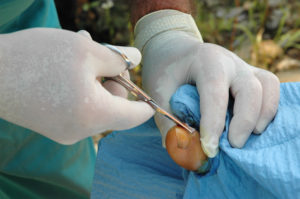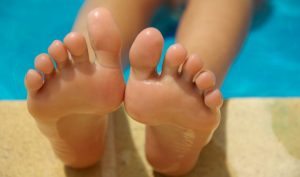Ingrown toenails can become infected, and when they do they can become very painful. Once infected, your toe may develop the following symptoms:
- Redness
- Oozing pus
- Swelling
- Painful to touch

Home Treatment or Podiatrist for Ingrown Toenails?
There are home treatments for ingrown toenails which include the following:
- Soak your feet in warm water – Do this for 20-30 minutes for up to 4 times a day to reduce the swelling of the toe.
- Apply an antibiotic cream – there are OTC (over the counter) antibiotic creams that you can purchase and apply directly on the affected area. Do this 2-3 times a day or as directed.
- Over the counter painkillers – Over the counter pain relievers can help when have pain caused by swollen ingrown toenails.
- Proper footwear – While your toenails are healing it is advisable to wear open toed footwear such as sandals and other open toed shoes.
Note that the home remedies for ingrown mentioned above can sometimes work, but there are instances that you need to seek the help of a licensed, professional podiatrist. If your condition does not improve within 3 days, consider going to Leanne Shields Podiatry right away or schedule a home visit.

NOTE: NEVER TRY TO CUT THE SIDE OF THE NAIL that’s infected, this may only worsen the situation.
What to expect From a Professional Podiatric treatment?
Depending on the severity of your ingrown toenails, a minor procedure may be conducted by one of our professional podiatrists. This minor procedure is called Partial Nail Avulsion (PNA). This procedure in very common and involves the removal of the offending nail edge.
FOR SEVERE CONDITIONS ONLY
For severe conditions our professional podiatrist may perform what’s known as Total Nail Avulsion (TNA). This procedure is rarely conducted.
How to Prevent Ingrown Toenails?
- There are several ways to prevent ingrown toenails. As with everything prevention is better than cure, so here’s what we recommend:Wear Comfortable shoes or footwear – No, we don’t mean those “Crocs” shoes (you can still wear fashionable shoes). The only requirements are:
- The shoes must fit your feet comfortably
- You don’t feel any pressure on your toenails
- Your shoes do not rub on your toenails or squish your toenails too tightly together.
- Cut your toenails properly – More often than not, ingrown toenails are caused by improper nail cutting techniques. Remember to cut your toenails straight across. Just make sure there are no spikes on the sides of your toenails.
- Wear toe protectors for uncomfortable shoes – sometimes you have to wear shoes that looks good with your ensemble, but let’s admit it, they can be uncomfortable. In this instance, we recommend wearing toe protectors.
If you are suffering from recurring ingrown toenails or you are currently suffering from an ingrown infection, contact Leanne Shields Podiatry today to set up your appointment without any hassles.
